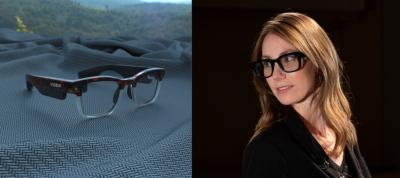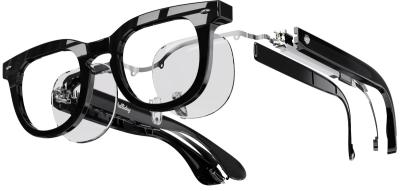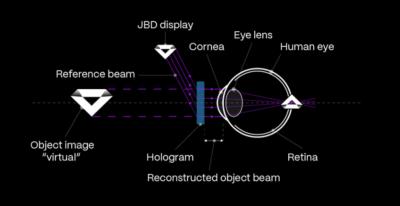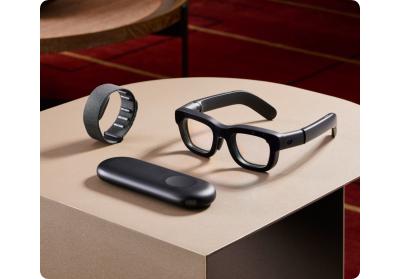 JBD (Jade Bird Display), established in 2015 in Shanghai, China, develops micro-LED based MicroDisplays for near-eye and image projection applications based on its proprietary hybrid monolithic integration technology.
JBD (Jade Bird Display), established in 2015 in Shanghai, China, develops micro-LED based MicroDisplays for near-eye and image projection applications based on its proprietary hybrid monolithic integration technology.
In July 2017 the company demonstrated a 5000 PPI active-matrix group III-V microLED array on Si ICs. In 2019 JBD unveiled more prototypes, including a 2 million nits display and a 10,000 PPI display.
In 2020, JBD became the first company to commercially produce microLED microdisplays - 0.3" VGA (640x480) monochrome (red, green and blue) displays. In 2023 JBD started shipping engineering samples of single-panel RGB microLED microdisplays.
In June 2022 JBD started building a $92 million USD display production line in Hefei. IN 2023, JBD said that its production line has commenced operation, and is producing microLED microdisplays.
1889 Hongyin Road
Lingang
Pudong New Area
shanghai
China
Halliday launches microLED powered AR glasses
Halliday launched their first AR glasses, called simply the Halliday Glasses. These enable a rather unique AR solution, that uses a monocular direct projection into the eyes without waveguides. The display engine is a green monochrome microLED microdisplay - likely produced by JBD.
The Halliday Glasses launched in a crowdfunding campaign, with a price tag of $400 (including a $90 discount for early supporters). The company aims to deliver the first products by April 2025. The company already has over 3,500 supporters and has raised over $1.4 million (with 41 days left to the campaign).
JBD developed a 2 million nits full-color microLED microdisplay, to start production in Q3 2025
China-based MicroLED microdisplay developer Jade Bird Display have developed a full-color microLED microdisplay that achieves a brightness of 2 million nits (white-balanced).
JBD says that its Phoenix series RGB microdisplays offer a pixel pitch of 5 micron, an ultra-thin stack of less than 5 micron, native RGB emitters and high color fidelity. JBD hopes to commercialize its full color microdisplays in Q3 2025.
INMO GO 2 AR glasses to feature JBD's microLED displays
INMO Technology officially launched its latest AR glasses, the INMO GO 2, that feature microLED microdisplays. The glasses use JBD's Hummingbird Mini II Optical Engine, with the company's 0.13" green monochrome VGA microdisplays.
The INMO GO2 offers real-time simultaneous translation technology, supporting 40 languages and 90 accents. The company says the battery life is 150 minutes of use on a full charge. The GO 2 are powered by a quad-core CPU and run on Android 9 with 2GB of RAM and 32 GB of storage.
Rokid announces new smart AR glasses with microLED microdisplays
Rokid announced a new AR headset, called Rokid Glasses, that are based on JBD's 0.13" VGA microLED microdisplays.
The Rokid Glasses offers a Snapdragon Qualcomm AR1 chipset, 12MP camera, 2GB of RAM, a battery life of 4 hours, and a charging carry case that can hold up to 10 full charges. The Rokid Glasses weigh 49 grams and offers several frame colors. Rokid will start selling the new AR headset by June 2025, with a price tag of 2,499 Yuan (around $350).
XPANCEO and JBD co-develop microLED microdisplays for Xpanceo's smart contact lens platform
MicroLED Industry Association member XPANCEO announced a partnership with Jade Bird Display (JBD) to develop integrated microLED displays for XPANCEO's smart contact lens platform.
It turns out the two companies have been working already on two different approaches. The first one (shown in the image above) uses a project and hologram combination, projecting an image at a distance so the eye can focus on it. XPANCEO already tested this approach with JBD's microLED projector, as an external device to the contact lens, and now the two companies are aiming to integrate the microLED projector unto the lens.
Meta announces $10,000 AR glasses powered by microLED microdisplays
Meta announced a new AR headset, called Orion. The glasses, that Meta says costs $10,000 to produce (and will probably be sold to something like that as well) are powered by microLED microdisplays. Orion packs quite advanced technology, including Silicon Carbide lens and advanced AI, but this is of course actually a prototype device, that Meta will offer commercially to developers or (very) early adopters. The Orion glasses weigh 98 grams, which still way more than what people consider to be light weight glasses (usually under 30 grams).
It is very nice to see the adoption of microLED technology by Meta. While some speculate that these microLED displays are made in-house by Meta using the Plessey Semiconductor technology and production line, it is also known that the company gave up on that course, and others speculate that these displays are produced by JBD, and are made from 3 separate monochrome microLED panels.
Even Realities launch new AR smart glasses powered by JBD monochrome microLED microdisplays
Even Realities launched a new smart glasses product, called the G1 - a lightweight solution that is based on dual JBD 0.13" VGA monochrome green microdisplays.
The G1 Glasses are available for pre-order for $599 (or $749 with prescription lenses). Shipments will begin in August.
MicroLED startups raise over $200 million in the past year
In the past year, microLED startups have raised over $200 million. As some companies (most notably Aledia and JBD in this case) mature and start to build production capacity, the need for funds grows, and we have indeed seen large investment rounds in these companies.
- Kubos Semiconductors: $2 million (May 2024)
- MICLEDI: $17 million (March 2024)
- Mojo Vision: $21.1 million (October 2023)
- Aledia: $129 million (October 2023)
- Comptek Solutions: $8.6 million (August 2023)
- QNA Technology: $4 million (August 2023)
- JBD: A4 round, estimated at $30-130 million (June 2023)
It is great to see these recent funding successes, which will hopefully lead to increased innovation and also initial production. It should be noted that most (if not all) of these financing rounds have been finalized before Apple made its decision to cancel its main microLED wearable project. We do not see Apple's decision as having a major impact on the long-term viability of microLED technologies or on the industry - but we do know that some investors are now hesitant to invest in this market following Apple's project cancellation.
Vuzix to develop microLED-based AR display systems for Garmin
Vuzix announced that it has signed a multi-phase development contract with Garmin for next generation nano-imprinted waveguide-based display system. These systems will also use microLED microdisplay engines.

Vuzix will develop and deliver in succession, waveguide based optical systems with full custom microLED projection engines, and then ultimately production units.
Vuzix launches online sales of its microLED-powered Shield Smart Safety Glasses
In early 2022, Vuzix launched the Shield Smart Safety Glasses based on microLED microdisplays (JBD's VGA 0.13"). The Shield, powered by Qualcomm's Snapdragon XR1 and Vuzix' propriety waveguide optics, was targeting enterprise use.

A few days ago, Vuzix announced that the Vuzix Shield smart glasses are now available to the general public, available to buy online at Vuzix's site. The company says that the Vuzix Shield is its most revolutionary pair of prescription-ready AR smart safety glasses, boasting enhanced 3D optics made possible by the stereoscopic microLED waveguide-based displays. At $2,499.99, this is still an expensive device and it is not really intended for general consumer use.
Pagination
- Page 1
- Next page









